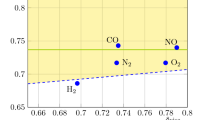Abstract
As a toy model study for the grazing collision effect in the Boltzmann equation, a spatially homogeneous problem for the two-dimensional Lorentz gas from the initial data with a jump discontinuity is investigated. The collision kernel of our model has the same angular singularity as the Boltzmann collision kernel. Thanks to the simplicity of the model, the jump propagation and its regularization are clearly seen, depending on whether the collision cross-section is finite or infinite. Three types of behavior are observed: a jump propagation, a jump propagation accompanied with a divergent derivative, and no jump propagation. For the model with a critical parameter, the switching from the second type to the last is observed.









Similar content being viewed by others
Notes
For smooth \(f\), we have
$$\begin{aligned} f(\cdot ,\cdot ,\varvec{\alpha _{*}})-f(\cdot ,\cdot ,\varvec{\alpha })&\sim -2\big (\varvec{\beta }\cdot \varvec{\alpha }\big )\beta _{i}\partial f/\partial \alpha _{i}\\&=-2\big (\varvec{\beta }\cdot \varvec{\alpha }\big )\big [\beta _{i}-\big (\varvec{\beta }\cdot \varvec{\alpha }\big )\alpha _{i}\big ]\partial f/\partial \alpha _{i}-2\big (\varvec{\beta }\cdot \varvec{\alpha }\big )^{2}\alpha _{i}\partial f/\partial \alpha _{i}, \end{aligned}$$for \(|\varvec{\beta }\cdot \varvec{\alpha }|\sim 0\) by the Taylor expansion. Since the derivatives of \(f\) are evaluated at \(\varvec{\alpha }\), they are independent of \(\varvec{\beta }\). As a result, the first term of the most right-hand side does not contribute to the integration with respect to \(\varvec{\beta }\). The last term reduces the degree of singularity from \(|\varvec{\beta }\cdot \varvec{\alpha }|^{\gamma }\) to \(|\varvec{\beta }\cdot \varvec{\alpha }|^{\gamma +2}\), allowing the integration down to \(\gamma =-3\).
For every fixed \(\gamma \) and \(\epsilon (>0)\), we have a large integer \(n\) such that
$$\begin{aligned} \big |\nu _{\gamma ,\epsilon }-b_{\gamma ,\epsilon }^{n}\big |=4\big |\int _{\epsilon /2}^{\pi /2}(1-2\sin ^{2}n\varphi )\,\big |\sin \varphi \big |^{\gamma }d\varphi \big |=4\big |\int _{\epsilon /2}^{\pi /2}\cos 2n\varphi \,\big |\sin \varphi \big |^{\gamma }d\varphi \big |\\ =\frac{2}{n}\big |\int _{n\epsilon }^{n\pi }\cos \phi \,\big |\sin \frac{\phi }{2n}\big |^{\gamma }d\phi \big |=\frac{2}{n}\big |\int _{n\epsilon }^{n\epsilon +2\pi }\cos \phi \,\big |\sin \frac{\phi }{2n}\big |^{\gamma }d\phi \big |\\ \le \frac{2}{n}\int _{n\epsilon }^{n\epsilon +2\pi }d\phi =\frac{4\pi }{n}\rightarrow 0,\quad \hbox {as }n\rightarrow \infty . \end{aligned}$$As will be clear in Sect. 5.1, the truncation at \(m=5000\) is not enough because \(\theta \)-derivative diverges. Required number of terms is larger than that for \(\gamma =-14/12\).
We shall prove \(\Psi (n+\frac{1}{2})>\ln n\) for any positive integer \(n\). The case \(n=1\) is obvious. For \(n\ge 2\), we use that
-
1.
For any positive integer \(n\), \(\Psi (n+\frac{1}{2})=-\gamma _{e}-2\ln 2+2\sum _{k=0}^{n-1}\frac{1}{2k+1}.\) [16, 17]
-
2.
Since \(1/x\) is downward convex, the trapezoidal formula bounds its integral from above:
$$\begin{aligned} \frac{1}{2}\left( 1+2\sum _{k=2}^{2n-1}\frac{1}{k}+\frac{1}{2n}\right) \ge \int _{1}^{2n}\frac{dx}{x}=\ln n+\ln 2. \end{aligned}$$
Then,
$$\begin{aligned} \Psi (n+\frac{1}{2})-\ln n&\ge -\gamma _{e}-\ln 2+2\sum _{k=0}^{n-1}\frac{1}{2k+1}-\frac{1}{2}\left( 1+2\sum _{k=2}^{2n-1}\frac{1}{k}+\frac{1}{2n}\right) \\&=\frac{2n+1}{4n(2n-1)}-\gamma _{e}-\ln 2+\frac{1}{2}+\sum _{k=1}^{n-1}\frac{1}{2k(2k-1)}. \end{aligned}$$Some manipulations from the first to the second line are omitted here. On the most right-hand side, the first term is positive, and the remainder is \(-\gamma _{e}-\ln 2+1(>0)\) when \(n=2\) and monotonically increases with \(n\). The desired inequality is thus obtained.
-
1.
\(\Psi (n+\frac{1}{2})-\ln n>0\) is proved in footnote 5 for any positive integer \(n\), where \(n\) corresponds to \(2m+1\). To prove \(\Psi (n+\frac{1}{2})-\ln n\le 1/n\), we use the formula for \(\Psi \) [16, 17] that
$$\begin{aligned} \Psi (x)=\ln x-\frac{1}{2x}-2\int _{0}^{\infty }\frac{t}{(t^{2}+x^{2})(e^{2\pi t}-1)}dt,\quad \hbox {for }x>0. \end{aligned}$$Then, for \(F\) defined by \(F(x)\equiv 1/x-\Psi (x+\frac{1}{2})+\ln x\) (\(x>0\)), we have
$$\begin{aligned} F(x)&=\frac{1}{x}+\ln x-\ln (x+\frac{1}{2})+\frac{1}{2x+1}+2\int _{0}^{\infty }\frac{t}{(t^{2}+(x+\frac{1}{2})^{2})(e^{2\pi t}-1)}dt\\&\ge \frac{1}{x}+\ln x-\ln (x+\frac{1}{2})+\frac{1}{2x+1}\equiv G(x)\rightarrow 0\quad \hbox {as }x\rightarrow \infty . \end{aligned}$$By the direct calculation of \(dG/dx\), \(G(x)\) is found to be monotonically decreasing for \(x>0\); thus we have \(F(x)\ge G(x)\ge 0\) for \(x>0\).
References
Cercignani, C.: The Boltzmann Equations and its Applications. Springer, Berlin (1998)
Sone, Y.: Molecular Gas Dynamics. Birkhäuser, Boston (2007)
Bird, G.A.: Molecular Gas Dynamics and the Direct Simulation of Gas Flows. Clarendon, Oxford (1994)
Sone, Y., Sugimoto, H.: Strong evaporation from a plane condensed phase. In: Meier, G.E.A., Thompson, P.A. (eds.) Adiabatic Waves and in Liquid-Vapor Systems, pp. 293–304. Springer, Berlin (1990)
Sugimoto, H., Sone, Y.: Numerical analysis of steady flows of a gas evaporating from its cylindrical condensed phase on the basis of kinetic theory. Phys. Fluids A 4, 419–440 (1992)
Sone, Y., Takata, S.: Discontinuity of the velocity distribution function in a rarefied gas around a convex body and the S layer at the bottom of the Knudsen layer. Transp. Theory Stat. Phys. 21, 501–530 (1992)
Takata, S., Sone, Y., Aoki, K.: Numerical analysis of a uniform flow of a rarefied gas past a sphere on the basis of the Boltzmann equation for hard-sphere molecules. Phys. Fluids A 5, 716–737 (1993)
Desvillettes, L.: About the regularizing properties of the non-cut-off Kac equation. Commun. Math. Phys. 168, 417–440 (1995)
Villani, C.: A review of mathematical topics in collisional kinetic theory. In: Friedlander, S., Serre, D. (eds.) Handbook of Mathematical Fluid Dynamics, vol. 1. Elsevier, Amsterdam (2002)
Desvillettes, L., Graham, C., Méléard, S.: Probabilistic interpretation and numerical approximation of a Kac equation without cutoff. Stoch. Process. Appl. 84, 15–135 (1999)
Lucquin-Desreux, B., Mancini, S.: A finite element approximation of grazing collisions. Transp. Theory Stat. Phys. 32, 293–319 (2003)
Pareschi, L., Toscani, G., Villani, C.: Spectral methods for the non cut-off Boltzmann equation and numerical grazing collision limit. Numer. Math. 93, 523–548 (2003)
Alexandre, R., Morimoto, Y., Ukai, S., Xu, C.-J., Yang, T.: Regularizing effect and local existence for the non-cutoff Boltzmann equation. Arch. Ration. Mech. Anal. 198, 39–123 (2010)
Le Bellac, M., Mortessagne, F., Batrouni, G.G.: Equilibrium and Non-Equilibrium Statistical Thermodynamics. Cambridge University Press, Cambridge (2004)
Takata, S.: Invitation to the kinetic theory. Nagare 27, 387–396 (2008). (in Japanese)
Abramowitz, M., Stegun, I.A.: Handbook of Mathematical Functions. Dover, New York (1972)
Moriguchi, S., Udagawa, K., Hitotumatsu, S.: Iwanami Sugaku Kousiki III. Iwanami, Tokyo (1960). (in Japanese)
Folland, G.B.: Fourier Analysis and Its Applications. AMS, Providence (1992)
Author information
Authors and Affiliations
Corresponding author
Rights and permissions
About this article
Cite this article
Takata, S. A Toy-Model Study of the Grazing Collisions in the Kinetic Theory. J Stat Phys 160, 770–792 (2015). https://doi.org/10.1007/s10955-015-1259-0
Received:
Accepted:
Published:
Issue Date:
DOI: https://doi.org/10.1007/s10955-015-1259-0




